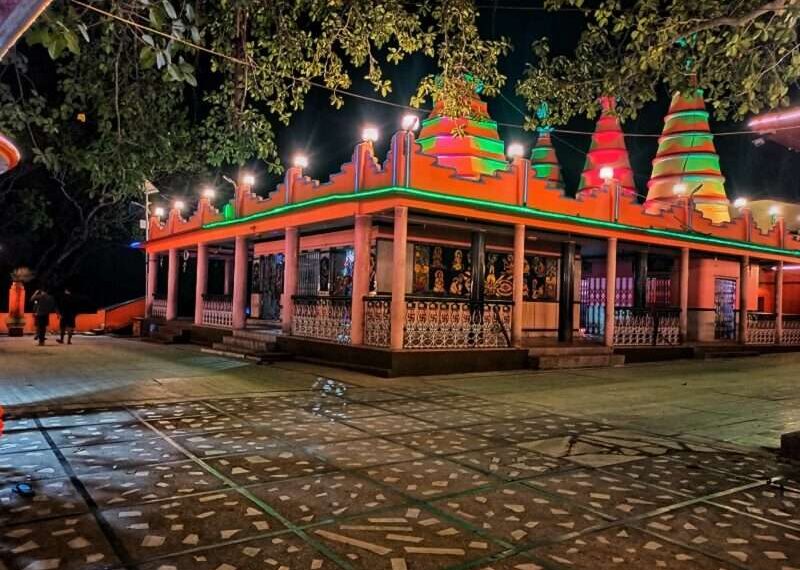Set on the crown of Binduwasni Hill in Barharwa, Sahibganj district, Jharkhand, Bindudham, also known as Binduwasni Mandir, is a divine place where devotees worship the Tridevi—Maha Durga (Kali), Maha Lakshmi, and Maha Saraswati—in the form of a Shakti Peeth. Built long ago, with roots in ancient times, this temple is famed for its link to Goddess Sati’s three sacred blood drops, a symbol of divine creation.
Notable Fact: The temple is revered as a Shakti Peeth where three blood drops of Goddess Sati fell, marked by a small stone shrine, a rare feature among India’s sacred sites.
Overview of Bindudham
Bindudham stands in Barharwa, 2 kilometers from Barharwa Junction railway station, a key Hindu pilgrimage site for Shaktism. Known for its Tridevi shrine, it houses a 1.5-meter stone idol of Maha Durga, flanked by smaller idols of Lakshmi and Saraswati, all under a single canopy. The temple complex, spanning 5 hectares, includes a 35-foot Hanuman statue and a Surya shrine. Devotees offer flowers, vermilion, and coconuts, believing the Tridevi fulfills their prayers. The temple trust, revived in the 20th century by Swami Hariharanand Giri (Pahari Baba), maintains the site, adding facilities in 2000. It is a sacred stop for Hindus and local tribes, tied to Sahibganj’s spiritual heritage.
History of Bindudham
Records trace the temple’s origins to ancient times, though the current structure was rebuilt in the 18th century after earlier decline. The Puranas link it to the Shakti Peeth where three blood drops of Sati fell after Lord Vishnu dismembered her dead body, naming the site Bindudham, meaning “place of the divine point.” A legend tells of a 5th-century sage who meditated here, guided by a vision of Sati’s blood, marking the hill sacred. By the 8th century, saints like Adi Shankaracharya visited, per local tales. The temple faded into obscurity until Swami Hariharanand Giri, known as Pahari Baba, restored it in the early 20th century, rebuilding the shrine and adding the Hanuman statue in 1960. In 2000, the trust expanded pathways and a prayer hall. The temple now hosts 3000–4000 daily visitors, peaking at 150,000 during Chaitra Navratri.
Architecture of Bindudham
Bindudham, set on a 50-meter-high hillock of the Rajmahal Hills, formed in the Jurassic Period, follows a simple North Indian style with a 3-meter-high dome. The main shrine, 8 meters by 8 meters, is built of red sandstone, housing a 1.5-meter black stone idol of Maha Durga, with 1-meter idols of Lakshmi and Saraswati on either side, all under a silver canopy. A 1-meter-wide stone slab, marked with three red dots, represents Sati’s blood drops. The complex includes a 35-foot Hanuman statue, 5 meters wide, and a 2-meter Surya idol on a seven-horsed rath, carved from granite. Four smaller shrines, honor Shiva, Ganesh, Kali, and Radha-Krishna.
of Sculptures of Bindudham
The temple’s heart is the 1.5-meter Maha Durga idol, black stone, four-armed, holding a trident and lotus, flanked by 1-meter Lakshmi and Saraswati idols, each with distinct symbols—Lakshmi with coins, Saraswati with a veena. The Surya idol, 2 meters tall, sits on a seven-horsed rath, carved with 0.5-meter sun rays. The 35-foot Hanuman statue, red sandstone, holds a mace, with 0.3-meter sacred footprints etched nearby. The main shrine’s walls bear 15 carved panels, depicting Durga slaying Mahishasura and Vishnu’s avatars, etched 2 centimeters deep, unpainted. The entrance arch, has floral carvings. Ancient bricks from the 1st millennium BCE, found during 2000 renovations, are displayed near the pond.
Rituals and Prayers
The temple operates daily, opening at 6:00 AM and closing at 10:00 PM. Chaitra Navratri (March–April) hosts a nine-day Maha Yajna. Other festivals include Govardhan Puja (November), Hanuman Jayanti (April), and Guru Purnima (July), each with 50 stalls. Animal sacrifices, mainly goats, occur on Tuesdays, with 100 animals weekly. The pond sees numerous ritual baths daily during Navratri, curing spiritual ailments.
Information for Travelers
How to Reach Bindudham, Barharwa
In Barharwa, 2 km from Barharwa Junction railway station, the temple is reached by auto, taxi, or a 30-minute walk, set on a hill.
By Air
Birsa Munda Airport, Ranchi, 300 km away, connects to Delhi (2.5 hours), Kolkata (1.5 hours), Mumbai (2 hours), Bangalore (2.5 hours). Taxis from Ranchi to Barharwa take 6 hours; buses take 7 hours.
By Train
Barharwa Junction, 2 km away, links to Bhagalpur (2 hours), Jamalpur (3 hours), Kolkata (5 hours), Delhi (20 hours). Autos to the temple take 5 minutes.
By Road
Barharwa connects to Sahibganj (54 km, 1.5 hours), Dumka (100 km, 2.5 hours), Ranchi (300 km, 7 hours) via NH-33.
Hours and Entry
Open daily, 6:00 AM–10:00 PM. Free entry; puja costs ₹100–400. No photography in the sanctum. Wear clothing covering shoulders and knees; women wear sarees or suits, men wear kurtas or dhotis.
Best Time to Visit
October to March, temperatures 14–25°C, suits visits. Chaitra Navratri (March–April) and Ram Navami draw crowds, book early. Avoid April–June, 25–40°C.
Nearby Attractions
Udhwa Lake, 20 km away, bird sanctuary.
Rajmahal Fort, 30 km, 16th-century ruins.
Kanhaiya Sthan, 25 km, Krishna temple.
Fossil Park, 35 km, Jurassic-era fossils.
Final Thoughts
In Bindudham in Barharwa, Sahibganj, Jharkhand, the Tridevi’s divine grace touches them who come, making it a place you must see among India’s holy spots. Its hilltop shrine, ancient blood drops, and sacred air draw the soul, bring peace, faith and devotion.











